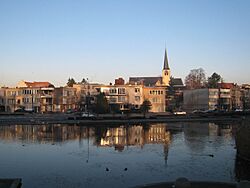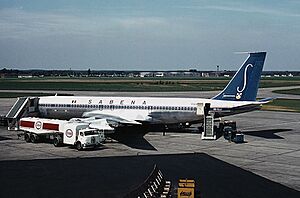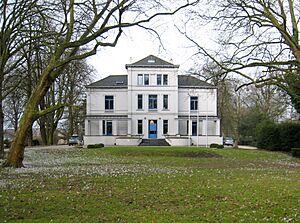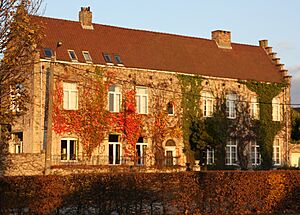Zaventem facts for kids
Quick facts for kids
Zaventem
|
|||
|---|---|---|---|
 |
|||
|
|||
| Country | Belgium | ||
| Community | Flemish Community | ||
| Region | Flemish Region | ||
| Province | Flemish Brabant | ||
| Arrondissement | Halle-Vilvoorde | ||
| Area | |||
| • Total | 27.62 km2 (10.66 sq mi) | ||
| Population
(2018-01-01)Lua error in Module:Wd at line 1575: attempt to index field 'wikibase' (a nil value).
|
|||
| • Total | Lua error in Module:Wd at line 1,575: attempt to index field 'wikibase' (a nil value). | ||
| Postal codes |
1930, 1932, 1933
|
||
| Area codes | 02 | ||
| Website | www.zaventem.be | ||
Zaventem is a town and a municipality in Belgium. It is located in the Flemish Brabant province, which is part of the Flemish region. Zaventem is found in the Dijleland area. This area is one of three big green spaces that make up the "Green Belt" around the Brussels-Capital Region.
The municipality includes the smaller towns of Nossegem, Sint-Stevens-Woluwe, Sterrebeek, and Zaventem itself. It is a suburb of Brussels. Sint-Stevens-Woluwe even borders the city directly, near the Woluwe-Saint-Lambert area.
As of January 1, 2006, Zaventem had 28,651 people living there. The total area is about 27.62 square kilometers. This means there were about 1,037 people per square kilometer. The official language in Zaventem, like the rest of Flanders, is Dutch. Zaventem is also home to Brussels Airport, which it shares with the nearby town of Diegem.
Contents
What Does the Name Zaventem Mean?
The older way to spell the town's name was Saventhem. But the very first time Zaventem was written down was as Saventa in records from 1117. People have different ideas about what the name means.
One idea is that it refers to seven small pools or ponds that were in the area long ago. Another thought is that it means small ponds in a sandy place. Some people also think Zaventem could come from "zeven tommen," meaning "seven burial mounds" from Roman times. Or it could mean "zaaivelden," which means "fields for planting seeds."
Zaventem's History
Zaventem's story goes way back to the neolithic (New Stone Age) and Roman times. We know from old burial sites that people also lived here during the Frankish Empire and the Merovingian dynasty.
Zaventem was first part of the County of Ukkel, then the County of Leuven. Later, it became part of the Duchy of Brabant. Around the 900s, the Abbey of Nivelles owned Zaventem. The town center grew where two important roads crossed: one between Vilvoorde and Tervuren, and another between Brussels and Erps. The church was at the heart of this growing village.
The church, named after Saint Martin, was built before the 800s. The Abbey of Nivelles owned it by the end of the 800s. In 1147, ownership moved to the Diocese of Cambrai. The church stayed with this diocese until 1559, when the Archdiocese of Mechelen took over.
Lords of Zaventem
From 1112 to 1122, a person named Ricardus de Saventen was a vassal (a person who held land from a lord) of Lambertus de Craynhem. Ricardus was known as the Lord of Saventhem. It's thought that the "de Saventen" family was a local noble family who lived alongside the "de Craynhem" overlords.
At that time, Forest Abbey and the Abbey of Kortenberg owned a lot of land. The feudal area of Zaventem then came to be owned by the knight Hendrik van der Meeren. His family owned it until 1605. They had a castle near the church, but it was taken down in the late 1920s.

In 1605, Ferdinand van Boisschot (1560–1649) became the Lord of Zaventem. He was an important official in the Duchy of Brabant. When he became a baron in 1621, Zaventem became a barony. This area then grew to include Nossegem, Sterrebeek, and Sint-Stevens-Woluwe. The de Boisschot family owned it until the French Revolution.
Long ago, there was a big forest northwest of Zaventem called Saventerlo. The Dukes of Brabant used to hunt there. Most of this forest was cut down in the 1600s.
Even so, Zaventem remained mostly a farming area for much of the 1800s. But its industrial history goes back to the 1200s. During that time, many water mills were built on the Woluwe River. These mills were later changed into paper mills.
In 1208, Godfrey, Duke of Brabant, ordered changes to the Woluwe River. This made sure the watermills had enough water. This really helped the paper industry in the 1700s and 1800s.
From the 1700s, Zaventem slowly changed from a farming community to an industrial one. Building the road between Leuven and Brussels (1705-1710) helped this change. After 1850, steam engines made industrialization even faster, which was not good for farming.
Over time, large farms were replaced by houses for workers. In 1866, a railway line between Brussels and Leuven opened. This split Zaventem into two parts and showed the start of a new industrial age. Besides paper, the tanning (making leather) industry also grew in the late 1800s.
In the early 1900s, the car company Excelsior made some of its famous cars in a Zaventem factory. All these industries led to the building of small castles and large villas for company leaders. One example is the Feldheim Villa, owned by a rich family in the tanning business. However, after World War II, many factories closed because they could not compete with foreign companies.
The building of Brussels Airport for the Brussels World's Fair in 1958 changed Zaventem's landscape a lot. This area used to be the large Saventerlo Forest. But the airport brought many jobs and greatly helped Zaventem's economy. With the growth of many industrial companies in the 1960s and 1970s, Zaventem became an important business center.
2016 Brussels Bombings
On March 22, 2016, two explosions happened at Brussels Airport in Zaventem at 7:58 AM local time. One was near the check-in desks, and another was next to a coffee shop. A third bomb was found and safely exploded by experts. The airport had to close for several days. Flights meant for Brussels Airport were either cancelled or sent to other nearby airports. Later, another explosion happened at a metro station in Brussels. A group called ISIL said they were responsible for these attacks.
Interesting Places to Visit
Church of Saint Martin and a Famous Painting

The Church of Saint Martin, named after Saint Martin of Tours, was built in 1567. It has been a protected building since 1938. The church was first built in a Romanesque style with three main sections, a tower, and a rounded end. In the 1500s, it was changed into a Gothic building and made even bigger in the 1800s. Inside, you can see a painting from 1618 called Saint Martin Dividing his Cloak by the famous artist Anthony van Dyck. It was placed in the church in 1621.
De Veste Museum of Local History
This museum shows old items, mostly borrowed from a local history group. You can see things people used in the past, like old weighing tools, farming equipment, and documents about local groups and businesses. There are also tools used by craftsmen and items related to the monarchy, church life, and the World Wars. Outside, you can see large farm machines like ploughs. The museum building was built in 1957 to look like a 17th-century house. In 1977, it was fixed up and turned into the local history museum.
Mariadal Castle
The Mariadal Castle is in the town park. It was built in the late 1800s by an archaeologist named Baron Emile de Munck. It has two floors and seven sections, with a round tower in one section. The roof has several windows sticking out. The building has been used for many things, like a public school, restaurants, and offices. In 1988, it was renovated and reopened as a cultural center for the community. The castle stands where an old 17th-century farm, Hof van Ophem, used to be. This farm was once a fief (land held by a lord) of the Duke of Brabant.
House of the Seven Knights
The House of the Seven Knights ("Huis der Zeven Ridders") is a building from the 1600s. It belonged to the du Bois or vanden Bossche family. So, it was actually called the vanden Bossche House. It's not really the "House of the Seven Knights."
In 1312, the ruling vander Meerens family from Sterrebeek bought a fief farm called The Seven Fiefs of Wezembeek. This was later sold to Ferdinand van Boisschot in the 1600s. Old papers mention "Seven Hereditary Lords of Zaventem" and the "Sevenantship of Wesembeeck" who made important decisions. They might have controlled the farm at some point. But the vanden Bossche House is a mansion from the 1600s, so it's not the house of these "Seven Knights." The vanden Bossche family owned many properties, so people respected them a lot, which might explain the confusion.
Stockmans Mill
The Stockmans Mill (Stockmansmolen) is the only watermill left in Zaventem. Its history goes back to the 1200s. Around 1450, this mill belonged to the van der Beke family, so it was called the ter Beke Mill. It was next to the ter Beke Court at that time. The court and the mill were separated in the 1500s and 1600s due to family inheritances and sales.
From 1675 until the early 1800s, the mill was owned by the important vanden Bossche family. In 1807, it was sold to Karel de Velder. During the Belgian Revolution of 1830, Dutch soldiers were in the fields near the Woluwe River. The miller, Karel de Velder, stopped the water flow to flood the fields, making the Dutch retreat.
Later, the mill became the property of the Stockmans family after Karel de Velder's granddaughter married Jan Philippe Stockmans. That's why it's called "Stockmans Mill." The watermill was used to grind grains and later as a paper mill. Watermills were very important for the early industries in the area. It worked until the mid-1900s but then fell into disrepair. A private owner bought it and fixed it up in the late 1980s to turn it into a restaurant. Stockmansmolen is now a popular burger restaurant.
Local Services
The Zaventem Fire Department (Brandweer Zaventem) helps protect the town from fires.
Railway stations in Zaventem include Zaventem, Brussels Airport, and Nossegem.
The town has a big road intersection where the Brussels Ring (R0) meets the A3 (which goes towards Leuven and Liège). The exit on the ring road for Zaventem is further north. The exit for the airport (A201), also called Zaventem, is actually in Machelen.
Zaventem's Economy
European Air Transport has its main office in Zaventem, at Brussels Airport. Belgium's airspace is known for being one of the busiest and most complex in Europe.
Ingersoll Rand has its European main office in Sint-Stevens-Woluwe, Zaventem.
Past Companies in Zaventem
Many airline companies used to have their main offices in Zaventem, especially near Brussels Airport. These included Virgin Express, SN Brussels, Sabena, Sobelair, Trans European Airways, CityBird, and Cargo B Airlines.
Brussels National Airport
Brussels Airport is Belgium's main airport. It covers a huge area of 1,245 hectares (about 3,076 acres). It handles around 225,000 flights and at least 19 million passengers every year, making it the biggest airport in Belgium.
The airport is located in the Flemish Brabant province, across the towns of Zaventem, Machelen, and Steenokkerzeel. The Brussels Airport Company runs it. The Belgian capital, Brussels, is about 12 kilometers (7.5 miles) away and can be reached by public transport.
How the Airport Started

The national airport's story began in the town of Evere. During World War I, the German army started building an airfield there. This was because it was close to Brussels, connected to a road, and had flat land. After the war, the Belgian air force took over the airfield.
In the late 1930s, the Belgian Ministry of Defence bought land in Melsbroek to build a new airfield. Soon after, World War II started, and the Germans set up an airport in Melsbroek during their occupation.
It wasn't until the 1950s that the Belgian government chose Zaventem for the national airport. Even Melsbroek was too small, especially with many visitors expected for the Brussels World's Fair in 1958. The Melsbroek area was then given to the air force.
The buildings for the Zaventem airport were designed between 1956 and 1958. It was first thought that the airport could handle up to 6 million passengers a year. The 1950s were a time when people strongly believed in new technology. This was shown in the airport's design, using materials like aluminum, concrete, steel, and glass. The main hall was meant to be very impressive, with a curved aluminum roof. Over the years, the airport has been expanded and changed, so much of the original design is now different. In 1994, Pier B opened, allowing 21 million passengers to be handled each year. Pier A opened in 2002 to make passenger flow better and more comfortable, handling another 25 million passengers annually.
Schools and Learning
Zaventem has both community and Catholic primary and secondary schools. It also has a community academy for music, speech, and dance. The Brussels American School, which is for children of US military staff working for NATO, is located in Sterrebeek.
Zaventem also has a public library.
Parks and Fun
There are seven parks located in Zaventem where people can relax and play.
International Connections
Zaventem is connected with other towns around the world. These are called twin towns or sister cities:
Images for kids
See Also
 In Spanish: Zaventem para niños
In Spanish: Zaventem para niños




















